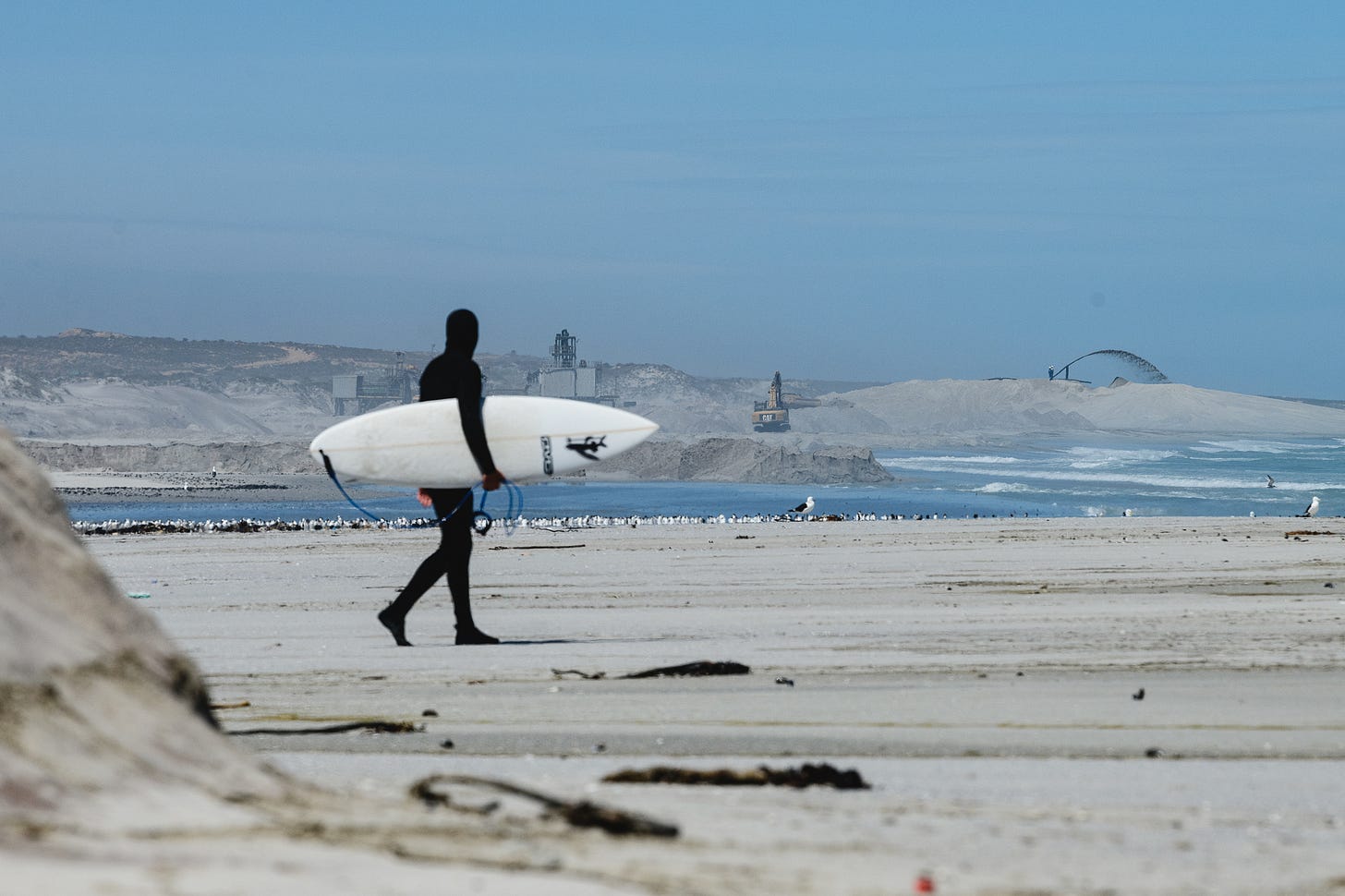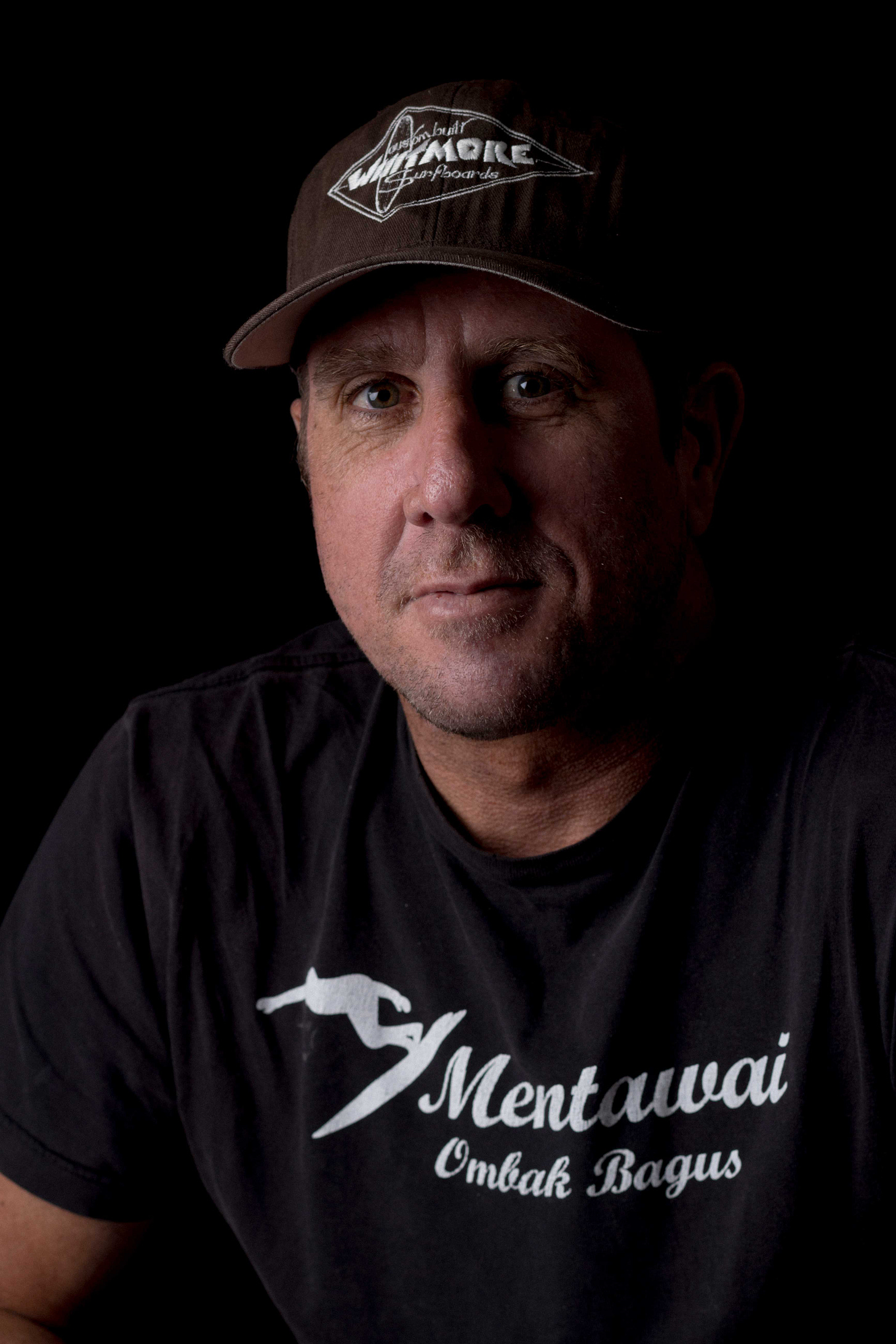“Know that you’re not alone.”
An interview with surfer and environmental activist Miles Masterson from Cape Town, South Africa

“Know that you’re not alone. If you’re feeling like you want to do something, it’s highly likely that someone else, close by or even faraway, is thinking exactly the same thing.”
I was first in touch with Miles in the late 2000s when I was the editor of Cooler Magazine and he wrote a great piece for us about surfing his home breaks in and around Cape Town. More recently, he showed up on my feed through his work at Protect the West Coast, a non-profit which seeks to end illegal and destructive mining on South Africa’s west coast.
It was great to catch up with Miles again and hear about the good fight he and other surfers, trail runners and concerned citizens are putting up to protect this unique coastal ecosystem. I hope you enjoy our chat.
Hey Miles, how’s the surf been lately?
It’s September, so it should be spring conditions now, but we just had another storm come through. I live in an area where we surf the beach breaks when the swell is a bit smaller, as when we get the storms it’s all on shore and 10 foot. So, I haven’t been surfing that much.
But we had a bit of a glimpse into summer two weekends ago when we had nice 4 foot swell and good waves at the beach breaks at nearby Llandudno. [The Hawaiian pro surfer] Nathan Florence just dropped a clip of him surfing there. He came to see [local big wave surfer] Frank Solomon, who runs Sentinel Ocean Alliance, a programme which aims to get kids from disadvantaged coastal communities into the ocean.

Are you finding the weather to be less predictable these days?
I’ve been surfing here since 1980, when I was nine, though I had quite a few years overseas. I’ve noticed the seasons seem to have shifted to later in the year and also the winds are different.
When I was younger, we used to get a lot of proper south easterlies, but over the years the prevailing wind has shifted more into the south, what we call the ‘devil wind’, which is cross-shore.
I don’t know if it’s the memory of youth, but I just remember things being really consistent, pumping swells for days on end. Now you’ll get a massive 24 second 18-20 foot swell that will just come marching through overnight and be gone the next day. We used to get a lot of windless days as well, whereas now it’s always blowing something.
I’ve always been interested in the weather since I was a kid. As a surfer, who grew up pre-buoys, and pre-internet, you had to really study the weather patterns. We’d go and get a newspaper in the morning and look at the synoptic charts for the isobars and also look at the clouds.
I used to surf a reef break at False Bay, just inside the tip of the Cape Peninsula and when the northwest is blowing it keeps the swell out of the bay, but as soon as that wind flips the swell comes around the corner, and we used to wait for it when I was younger. A lot of that knowledge has been lost with the youngsters and their webcams and apps.
At 52, I’m carrying lots of old injuries so whenever there is a front coming up, I get aches in my knee. I tell my 13-year-old son, who surfs as well, there’s a front coming and it’s going to rain later, though he just laughs and says: “Shut up, dad.”
Does being that connected to your environment tie into your work with Protect the West Coast?
Hugely. I first went surfing up the west coast when I was 12 years old. I went to Elands Bay and absolutely fell in love with the place straight away. I was actually born in Namibia, so I was born on the west coast, and feel a really strong connection to that part of the world.
We’ve always known the miners have been getting away with murder, well murdering the environment, diamond mining has been happening there since the 1890s, but for most people, it’s been out of sight, out of mind.
Then in lockdown, this Australian-owned mining company, who already had a mine on the coast, somehow got an extension to mine another 10 beaches further north. A couple of those spots are world class beach breaks, surfed by the likes of Kelly Slater, Mick Fanning, Carissa Moore, Greg Long and Twiggy Baker. One particular beach break is like Puerto Escondido, it can handle 15-20 ft faces, it’s a remarkable wave.
Our founder Mike Schlebach went to surf there in 2020, just after the hard lockdown finished in South Africa, but he was barred from getting to the beach. The beaches are public land, but the mining company had suddenly said you couldn’t use the access road. He went anyway and on his journey home, which is a three to four hour drive, he came up with the idea for Protect the West Coast.
What kind of impact do the mines have on the beaches?
They dig great big holes on the beach, then dump all the sand on the side. It’s like a Mad Max scene, with all this machinery sifting the sand. Even five years ago the tech wasn’t in place to make it cost effective for the companies to mine these heavy minerals in these areas, but now as the tech has advanced it’s become feasible.
Recently, we had a major victory, with an out of court agreement with a mining company who were, among other things, threatening to mine in an estuary, this pristine beautiful estuary, about an hour’s drive north of Elands Bay. These guys wanted to come in and mine for diamonds on the banks of this river, which would have killed the livelihoods of the artisanal fishing community there.

A lot of people think of the west coast as quite stark and like a desert but it’s not, it’s semi-arid, with such a wealth of unique flora and fauna, hundreds of endangered species, and biodiversity that doesn’t exist anywhere else in the world.
What they are doing is purely motivated by economic gain; they’re not interested in the environment. Our guestimate is 80-90 % of the areas that have been mined on the west coast have just been left, the miners just pack up and go, and leave this Mad Max-style moonscape behind.
And it’s not just surfers affected by the restricted beach access – it’s mountain bikers, trail runners, fishers and crucially it’s blocking access for the First Nations people, who traditionally rely on fishing to survive in one of the most economically deprived regions of South Africa. They were shafted by the Dutch colonialists, then the British, then the apartheid government and now the current government is shafting them again. These mining companies are extremely powerful and well resourced.
Has the surf community been supportive?
Two of our most vocal supporters from day one have been Twiggy Baker and Frank Solomon, who are well known South African big wave riders. They’re both good friends with John John Florence and he shared a campaign we did on Instagram, and we got thousands of followers, so that was really helpful.
But this isn’t about a bunch of privileged surfers wanting to ensure access to our favourite surf breaks, this is about the environment, and the people of the west coast who make the place what it is.
Tourism has only recently started to kick on there. But the history of surfing goes back to the father of surfing in South Africa, John Whitmore, who discovered breaks up there in the 1950s. That sense of exploration and discovery and camping in the wild, is what surfers have been doing for decades up there, but it’s only really through the formation of Protect the West Coast that we’ve had this sense of unified purpose with the tribal and community leaders and other concerned groups such as trail runners and mountain bikers.
What learnings can other people take from your experience with Protect the West Coast?
Know that you’re not alone. If you’re feeling like you want to do something, it’s highly likely that someone else, close by or even faraway, is thinking exactly the same thing. And just by taking a step at being active in some way, whether that’s starting a group online and asking if anyone feels passionately about this particular issue or whatever, things will start to happen. Build it and they will come, that’s literally what we’ve done.
To find out more about Protect the West Coast head here & here.
Other news:
Stoked to say I’ve been shortlisted in the ‘Sustainability Feature of the Year’ category at this year’s Travel Media Awards. It was for this Guardian piece on how Chamonix’s mountain guides are adapting to the climate crisis.
And I loved this Henry Wismayer article for the New York Times on ‘The Slow Death of the Sun-Seeking Summer Vacation’. I think about what he calls “climate change’s totalizing potential” a lot.
Please fwd this newsletter to anyone who you think might be interested & if you have any story tips on any of these themes pls get in touch.





A local break called Llandudno? Please tell me there’s one called Rhyl as well